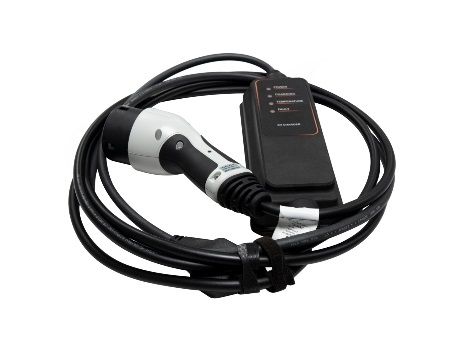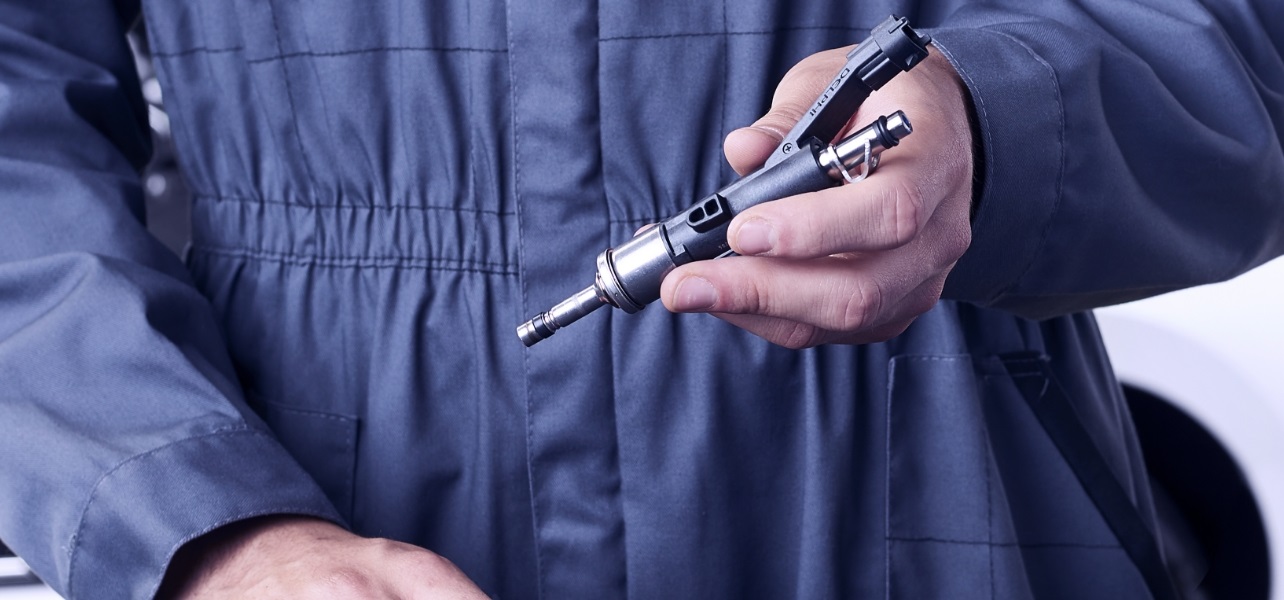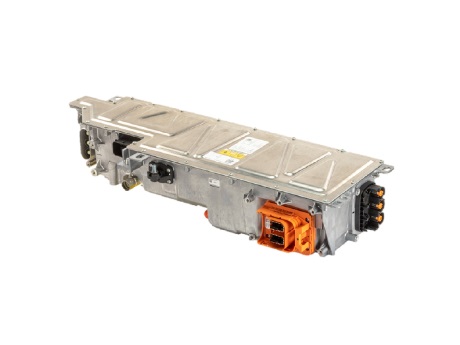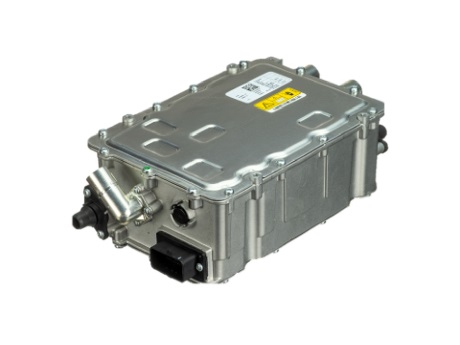Charge Mode 2 Cables

Proven durable EV charging cables that last
Delphi Charge Mode 2 Cables are in serial production at multiple major OEMs. Tested according to automotive Standards (LV124), our proven design offers reliability and performance that exceed well beyond compliance. The In-Cable Control- and Protection Device (IC-CPD) allows drivers to safely charge their battery-powered electric vehicle (BEV) or plug-in hybrid electric vehicle (PHEV) without the need for a dedicated circuit or EV charging station.
Our robust design of the in-cable control (ICC) box make it not only drive over resistant* (acc. IEC 62196-1) but able to handle extreme temperatures ranging from -30°C (-22°F) to +50°C (122°F), all the way up to +70°C (158.0°F) in storage. With superior water sealing protection* of immersion in 1 meter, well beyond the 5cm standard* (IP67 High sealing performance (1 meter)), the IC-CPD is durable enough for anything nature throws at it.
And to ensure a service life that lasts just as long as the expected battery life of a vehicle, our IC-CPD is designed to last over 10,000 mating cycles- That adds up to a service life of 9 years if used 3 times a day!
Safe EV charging to protect you and your vehicle
When working on anything electrical, safety is our top priority. That’s why Delphi Charge Mode 2 Cables are fully compliant with the IEC 62752 standard and protect you and your vehicle from dangerous electrical faults that can cause damage, shock, fire, or worse.
Shock protection: When the vehicle charging inlet and grid socket are properly connected, all terminal interfaces and terminals are fully protected against contact. Type B RCD residual current detection (RCD) detects fault currents and disable the charging process.
(NA ONLY) Ground monitoring: IC-CPD measures the protective conductor resistance and stops the charging process if the measured value is too high.
Overheating protection: Dual thermal sensors in the grid plug and sensors inside the ICC box monitor temperature.
Short circuit protection: Short-circuit management capability, will the IC-CPD protects on short circuits at EV.
Overvoltage protection: IC-CPD protects EV from overvoltage.
| Countries* | Connector Type | Current | Charge Level | Cable Length (m/ft) | Grid plug type | Part Number |
| North America | SAE J1772 / Type 1 | 10A | Level 1 | 5.0 / 16.42 | NEMA 5-15 / 90° | PLV10001-11B1 |
| Europe | Type 2 | 10A | Level 1 | 5.0 / 16.40 | Typ E/F 90° | PLV10003-12B1 |
| UK | Type 2 | 10A | Level 1 | 5.0 / 16.42 | Typ G | PLV10005-12B1 |
| Switzerland | Type 2 | 8A | Level 1 | 5.0 / 16.44 | Typ J 90° | PLV10007-12B1 |
| Norway | Type 2 | 10A | Level 1 | 5.0 / 16.45 | Typ E/F 180° | PLV10008-12B1 |
| Denmark | Type 2 | 6A | Level 1 | 5.0 / 16.43 | Typ K 90° | PLV10010-12B1 |
| Finland | Type 2 | 8A | Level 1 | 5.0 / 16.41 | Typ E/F 90° | PLV10011-12B1 |
| Italy | Type 2 | 8A | Level 1 | 5.0 / 16.46 | CEI 23-50 / 90° | PLV10009-12B1 |
| China | GB/T | 8A | Level 1 | 5.0 / 16.42 | GB 2099 / 90° | PLV10015-12B1 |
*For a full list of countries available, please contact your Delphi representative.
| What is Level 1 AC charging? | A charging “level” in EV terminology refers to the electric power distribution type, standards, and maximum power of a charging system as defined by SAE J1772 and internationally adopted under IEC 62196-1. Sometimes referred to as “trickle charging”, level 1 charging is perfect for plug-in hybrid vehicles and offers a great alternative charging option by providing a home charging station. By using existing infrastructure, electric vehicle owners save on installation costs while still being able to fully charge their battery overnight. And because the charger is portable, it can easily be stored in any EV luggage compartment, making it perfect for short commutes, overnight charging, or an emergency charge. | A “Level 1” AC charge pulls electrical energy from the power grid via a standard 120V household outlet and capable of supplying an average maximum of 16 A and 1.92kW. The electric vehicle’s on-board charger then converts and stores this energy for the electric motor. Depending on the vehicle, level 1 charging usually takes 12 to 24 hours to get a full charge on a fully depleted battery. |
| What is mode 2 EV charging? | A charging “mode” in EV terminology refers to the mode of power delivery, control, and protective equipment of a charging system as defined by IEC 61851-1, the international standard for electric vehicle conductive charging systems. | “Mode 2" uses a cable incorporated with a protection device to connect the electric vehicle to a household socket outlets. |
Our cables use In-Cable Control- and Protection Device (IC-CPD) to provide a standard grounded power connection to residential building sockets from 100 V to 240 V 50/60 Hz (depending on the model variant) and a charging current of 6 A up to 16 A.
An alternative EV charging option for peace of mind
For drivers that suffer range anxiety- the fear that a vehicle has insufficient range to reach its destination- having a Charge Mode 2 cable available on hand can offer some peace of mind. It also ensures that your vehicle will be charged and ready for use when needed with automatic reset.
Our built-in Auto-Reset feature provides a restart in the event of a temporary power grid fault, such as excessive voltage or a brownout. The charging dock will automatically clear any error codes when the cause of the temporary error condition returns to normal and then attempt to restart the charge.
To learn more about OE quality aftermarket EV parts you can trust, contact your Delphi representative today.
The Delphi Difference
-
100 years of OE experience, supplier to the world’s top automakers
-
OE heritage and knowledge built into every aftermarket part
-
Comprehensive portfolio for a wide range of vehicles and model years
-
Streamlined SKUs for easy inventory management
-
Support through tools, tips and training

Related product resources and downloads

Safety tips to consider when working on hybrid vehicles
Resource Highlights
Auto IQ | Regulatory demands for better fuel economy and reduced emissions will continue to drive the increase in hybrid vehicles on the road today and for the future. In fact, by 2020, it is projected that volumes will nearly triple from the 2M vehicles produced in 2012. So there is no doubt we will continue to see an increase in the number of hybrids entering the aftermarket once the warranty period ends. Today’s technician must keep up-to-date on the latest in hybrid technologies so they can effectively and efficiently serve their hybrid customers and provide options for service and repair. Due to the high-voltage circuits contained in most hybrid vehicles, proper service takes on a whole new approach. Improper handling of the hybrid system may result in electrocution and damage to vehicle components. Whenever servicing hybrid vehicles it is important to closely follow the service procedures found in the approved vehicle manufacturer repair manual. Each hybrid is unique and the proper procedures need to be followed for locating and removing or switching off service plugs and switches prior to servicing the vehicle. There are a variety of tools required to help diagnose and service hybrid vehicles. First, and foremost, a quality diagnostics scan tool is critical for accurate repairs. Additionally, a Category III DVOM is a must for diagnosing high voltage hybrid vehicle circuits. Meters such as the Fluke 1587 allow for insulation testing as well as performing all the other functions of a CAT III meter. |
Step by Step
1. | Safety TipGlovesAlways wear high-voltage insulated gloves rated to 1000 volts minimum, Class 0, while diagnosing and servicing hybrid vehicles and systems. Use gloves that are in good condition, as even pinholes can be very dangerous. One method of testing a rubber glove for leaks is to blow into the glove and hold it tight by squeezing or rolling the open end tight. If the glove has a leak it will deflate. |
2. | Safety TipWheel DolliesHigh voltage circuits are typically identified by bright orange cables or wires. The wiring may also be covered by bright orange covers or conduit. When hybrid vehicles are in a shop for service the vehicle may need to be moved. Remember, if you are rolling a vehicle in the shop, with the drive wheels on the ground the motor generator may be providing power to these circuits. To avoid this condition wheel dollies are recommended to move hybrid vehicles around the shop. |
3. | Safety TipHave we met?Always remove all jewelry including watches, necklaces, earrings, etc. when working on a hybrid vehicle. Metal objects conduct electricity and could be a hazard if they inadvertently contact a voltage source. Wear the appropriate protective clothing (high voltage rubber gloves, face shield, insulated boots, protective coat or apron) when servicing hybrid vehicles. |
4. | Safety TipRe-set The VehicleDuring diagnosis, do not drive the vehicle in this “Service Mode” as it may damage the transmission or other components of the hybrid system. To re-set the vehicle, shut the vehicle off and restart. |
5. | Safety TipDisable "Smart Key" SystemIf a hybrid is equipped with a “smart key” system the technicians need to be sure the system is disabled prior to performing any service on the vehicle. When in “Ready Mode” the engine can start at any time, which could create a safety concern if this occurs during vehicle service. |

Visit our Technician Library for access to Documents and Downloads
Get in touch
The full Delphi Power Electronics product range

Find out where to buy Delphi parts




